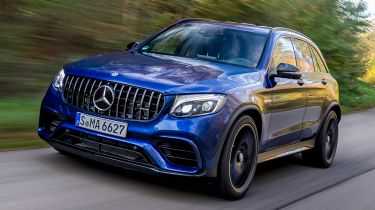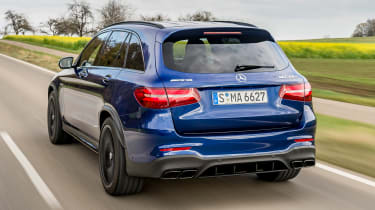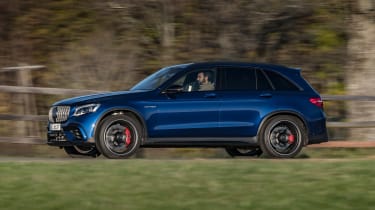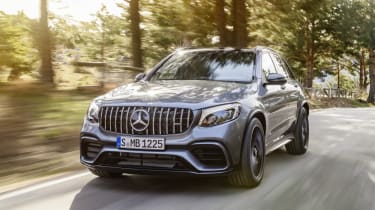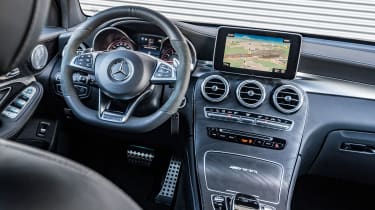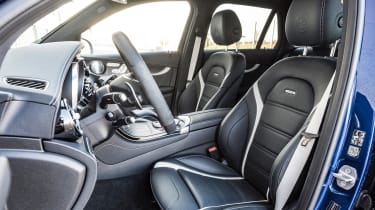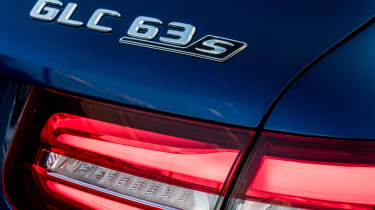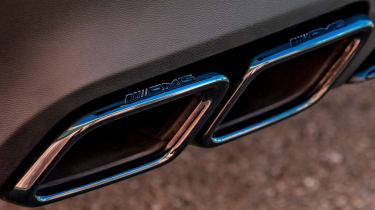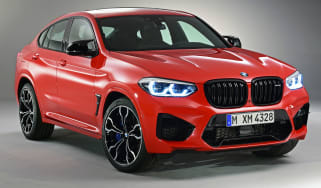Mercedes-AMG GLC 63 SUV (2015-2021)
“The Mercedes-AMG GLC 63 is faster than a Porsche Macan, but even driving enthusiasts may baulk at its price and running costs”
Pros
- Hugely fast
- Desirable image
- As practical as ever
Cons
- Poor economy
- Jittery ride on big wheels
- Twitchy steering
The Mercedes-AMG GLC 63 is the result of Mercedes’ SUV sales success on the one hand and the popularity of its sporty AMG models on the other. In theory, merging them together should have created 2017’s most desirable new car. At least in countries where fuel is cheaper than it is in the UK anyway, because if there’s one thing the ripsnorting GLC 63 isn’t, it’s economical.
But neither are the GLC 63’s closest rivals, including the Porsche Macan Turbo, Audi SQ5, supercharged Jaguar F-Pace and the Alfa Romeo Stelvio Quadrifoglio. Each one is a ‘halo car’ for their respective manufacturer’s SUV line-up, as the vast majority of these SUVs will actually be sold with a 2.0-litre diesel engine under the bonnet.
With double that capacity, the 4.0-litre twin-turbo V8 petrol in the GLC 63 makes either 469 or 503bhp, depending if you go for the ‘standard’ version or the even faster GLC 63 S. Do so and your SUV can get from 0-62mph in 3.8 seconds, while optional features like ceramic brakes will be more familiar to supercar owners and racing drivers.
Despite all this performance, the comfortable and practical GLC interior has been kept intact, except for an occasionally jittery ride courtesy of firm suspension and large alloy wheels. These help make the steering and chassis feel precise but may prove tiresome on UK roads, so we’d recommend the standard 19-inch wheels. The GLC 63 is also fitted with 4MATIC four-wheel drive and a nine-speed automatic gearbox as standard, so not only does the driving experience give you a sense that the fastest GLC is unflappable, it should also prove capable in wintry conditions.
As you’d expect for an SUV costing around £70,000, equipment levels are generous, with the standard model getting Mercedes’ impressive Comand Online infotainment system and Nappa leather seats. The ‘S’ version increases the wheels to 20-inches in diameter and adds AMG seats, an AMG Track Pace app and a rear differential lock for added traction.
More reviews
The GLC 63 S Edition 1 was offered from launch. It costs over £90,000 and, with lairy yellow decals and black and yellow 21-inch alloy wheels, it’s likely to be a niche proposition. It does add desirable features like a sports exhaust, Burmester stereo and ceramic brakes, but these are all on the options list for the standard model.
While the engineering of the GLC 63 is impressive, Mercedes’ 21st place in our 2017 Driver Power owner satisfaction survey is a worry, even if the brand came 16th for reliability, and Mercedes will be hoping for a better result next year. Safety is guaranteed, though, with a five-star score from Euro NCAP.
MPG, running costs & CO2
The handbuilt engine fitted in the GLC 63 is designed for performance, and that’s reflected in its running costs. Fuel economy figures of 27.4mpg and 26.4mpg for the S version are certainly nothing to brag about in a year when sales of hybrids, plug-in hybrids and electric cars has shot up by over a third. The Porsche Macan Turbo Performance Pack can return 30.1mpg, and while not quite as fast, the Audi SQ5 can manage a slightly more palatable 34mpg. The supercharged Jaguar F-Pace can return 31.7mpg, but is also down on power compared with the Mercedes. If you’d like a more economical alternative, the Mercedes-AMG GLC 43 is likely a better compromise, managing 34mpg.
Carbon dioxide emissions are high too, with the lowest figure of 234g/km putting it in the top 37% Benefit-in-Kind (BiK) for company-car drivers. Upgrade to larger wheels or the S version and emissions increase to 244g/km. The Audi SQ5 emits 189g/km, while the range-topping Jaguar F-Pace emits 209g/km and the Porsche Macan Turbo Performance Pack creates 217g/km.
After the first year's CO2-based road tax (generally included in the on-the-road price), all Mercedes-AMG GLC 63 S cost £140 a year to tax. With a list price (including options) of more than £40,000, they’re also liable for an additional surcharge of £310 a year in years two to six, bringing the annual bill to £450 during that period.
With sportscar performance, insurance was never going to be cheap, and groups 46-47 out of 50 mean it certainly isn’t. For reference, an entry-level GLC 220d sits in group 32, while the GLC 43 is only slightly more affordable in group 43.
Servicing plans will be available, allowing payments to be split across 24 or 36 months, but prices for the AMG are likely to be more than the £35 a month for a regular GLC. Meanwhile, Mercedes’ provide a three-year/unlimited-mileage warranty, which is on a par with most rivals.
Engines, drive & performance
Taking the 4.0-litre twin-turbocharged V8 petrol engine from the Mercedes-AMG C 63 S and the latest nine-speed automatic MCT gearbox from the E 63 S makes for a formidable combination. Here you can choose the engine in its ‘basic’ 469bhp configuration, or in the flagship ‘S’ version with 503bhp. Either one puts this medium-sized SUV ahead of the Porsche Macan in the power stakes and gives customers the equivalent of a high-riding hot rod.
At the drag strip, the GLC 63 S will romp from 0-62mph in a scarcely believable 3.8 seconds, a second faster than the Porsche. In fact, it’s faster than most of the sports cars you’ll be looking down on at traffic lights. Choose the AMG Driver’s Package (costing £2,800) from the options list and the limited top speed is increased from 155mph to 174mph. While that’s not really of much use unless you take the car to a track, the £1,000 sports exhaust is almost a given if you want to hear the V8 in all its glory.
AMG models might not be as unruly as in the past, but with its traction control turned off, the GLC 63 S has enough brute force to spin its tyres out of junctions and slow corners. In most situations, the 4MATIC+ four-wheel drive system keeps things civilised, providing impressive traction. The steering is bordering on too sharp, with the Porsche Macan feeling more natural to drive as a result, but the GLC exhibits impressive control and barely leans in corners. The new gearbox dispatches its shorter gears quickly while still having enough left for sedate cruising, but it can sometimes fail to respond if you try and change down several gears at once.
Interior & comfort
Despite the interior being even more plush than a regular GLC’s, things are less comfortable on the move, with the performance suspension and huge 20-inch alloy wheels of our test car making it noticeably firmer and more prone to following ruts in the road. In the UK it might be wise to stick with the standard 19-inch wheels and slightly plumper tyres.
Equipment levels are generous, with Nappa leather sports seats and Mercedes’ intuitive Comand Online infotainment system included, as well as all the performance upgrades and a muscular exterior makeover. Other interior features include a memory function for the front seats, ambient lighting (with three colours to choose from), an AMG instrument cluster and a flat-bottomed steering wheel.
Practicality & boot space
The GLC 63 hasn’t lost any practicality as a result of its go-faster modifications, with the same 550-litre boot that’s a noticeable 50-litres bigger than the Porsche Macan’s. You’ll also get all the advantages of that SUV bodystyle, with wide-opening doors, lots of headroom in the front and back and a comfortable, raised seating position.
Flip the 40:20:40 split and fold rear seats down with the boot-mounted lever, and the boot floor is almost flat, providing up to 1,400 litres of luggage space.
A central transmission tunnel eats into legroom for a middle passenger in the back, but four adults will be very comfortable indeed. They’ll also have plenty of places to put their things, because each seat has cubbies and cup holders within easy reach, and there’s quite a bit of storage in the central console.
Unlike most AMG models, the GLC 63 and 63 S are both rated for towing, although somewhat surprisingly given their prodigious power and huge brakes, their 2,200kg limit for a braked trailer is 300kg less than diesel versions. Still, 2,200kg should be plenty for towing even a large caravan.
Reliability & safety
When it comes to reliability, there is some cause for concern. While the GLC 63 is undoubtedly a luxury product with impressive engineering, Mercedes could only manage 21st place overall out of 27 manufacturers in our 2017 Driver Power owner satisfaction survey. However, despite 15.2% of Mercedes customers reporting a fault within the first year of ownership, the brand came 16th in the reliability category - a slightly better performance.
There are no safety concerns thanks to a full complement of collision-mitigating technology and plenty of kit to keep you safe should the worst happen. Euro NCAP gave the GLC five stars after its tests in 2015, with a reassuring 95% score given for the adult occupant protection category.
Price, value for money & options
Considering the GLC 63 is both a luxury and very high-performance SUV with a Mercedes badge on its nose, it should come as no surprise it’s priced accordingly. Costing from £69,000 for the standard version, £75,670 for the GLC 63 S and £90,824 for the Edition 1, the Mercedes compares with £64,000 for a Porsche Macan Turbo and £69,500 for the Performance Package, while you’ll need £86,000 for a Macan Exclusive Performance Edition.
Choosing the Edition 1 version adds Grey Mango paint, yellow decals, ceramic brakes, a sports exhaust, 21-inch black alloy wheels with yellow detailing, a Burmester stereo and diamond-pattern leather seats with yellow stitching.
We’d recommend sticking with one of the standard models and adding the Premium package (£2,600) instead, which includes keyless entry, the Burmester stereo, LED headlights, a panoramic sunroof and leather dash trim in a more discreet-looking SUV.

